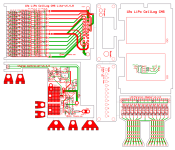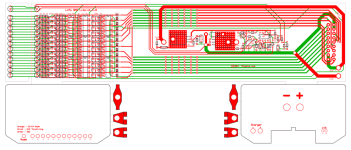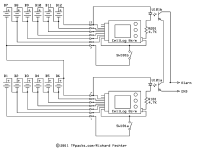Okay, we are getting closer.

We made a slight change to the HVC control philosophy, which improves a number of things. Previously we had the HVC opto outputs in series, and then used this signal to trip the EOC shutdown logic. The idea being that once all the shunts were fully on, the cells were all full so the charge current could be shut off. This works quite well, but it means that until the last cell's shunt comes on, the rest of them are cooking away because they are saturated. To prevent for the case where you have one weak/bad cell from running away in an overvoltage condition, we used the CellLog's HVC signal, but set higher, like around 4.20-4.25V. If a cell tripped this limit the EOC shutdown would also be engaged.
The next change was to add this secondary HVC signal to the standalone variants as well, so there'd be the same sort of errant cell protection. What we did was to implement two HVC signals, one a bit higher than the other. The lower one drives a series string of optos, which means for the signal to go active
all of these lower HVC signals need to be on. The second, higher HVC set of signals drive a "standard" parallel string of optos, so this HVC signal will trip if
any of these higher HVC signals trip. In the charge control logic, we still use the
ALL HVC line to trip the EOC shutdown, but with this latest version we will now use the
ANY HVC to do the same sort of power cycling/throttling we've done in the past. This will still keep the errant cells from going too high, but it also means the shunts that come on first won't go into a swamped/overload condition, so they will run much cooler. This is particularly important for the 12s2p "shrink wrapped" version.
All-in-all, this is a much better control scheme, as it can be used with a wider variety of charge setups. There's a few more parts, but well worth the extra time and effort, in my opinion.

I ordered some of both of these PCBs this morning:


The first one is for the "boxed" version, which uses the embedded LVC/parallel adapter boards. The standalone (i.e. -- non-CellLog...) version contains the shunt circuits, including both ANY HVC and ALL HVC signals, plus the new charge controller. This box can either be used as a "CMS", and only connected via the single 18-pin charge plug, during the charge process, or it can be left permanently connected to the pack. There's no drain on the cells because the charge control logic, including the main LED, is off until the charger/supply is connected. If CellLogs are to be utilized, the box can be used as a CellLog-based CMS unit and the CellLogs can be used to generate the ANY HVC signal. For this case, the custom lid is used, which also includes the CellLog alarm signal isolation circuits.
The second PCB is the updated 12s2p shrink wrapped "kit" version. This variant is functionally identical to the boxed version, plus the LVC/parallel adapter board, but contains everything on one board that runs along the bottom of the 12s2p pack. Special end plates are provided to stick on the ends of the pack, prior to shrink-wrapping the whole assembly. This variant can use either 6s-5000, 6s-5800 or 6s-8000 Turnigy/Zippy packs.
I will get these boards on Thursday, and will spend the weekend doing verification tests, to make sure I didn't screw anything up and that everything works right. Assuming that effort is successful, I'm hoping we will be able to start making both of these variants available starting next week sometime.

-- Gary







